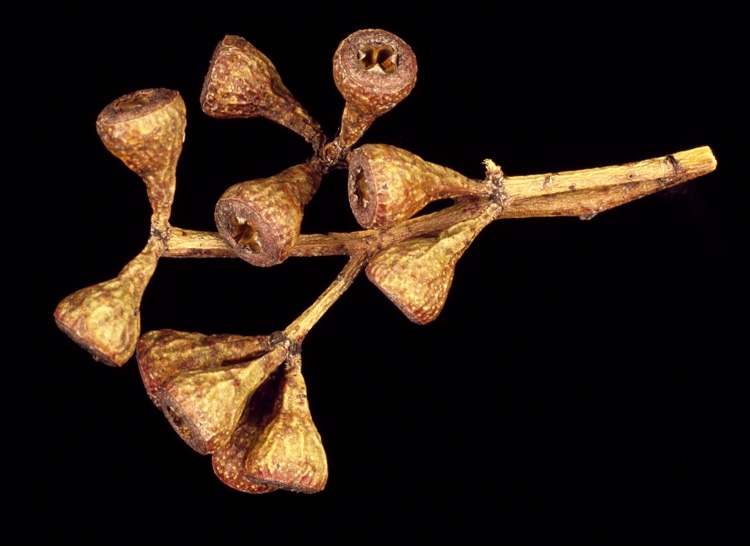Eucalyptus Consideniana on:
[Wikipedia]
[Google]
[Amazon]
''Eucalyptus consideniana'', commonly known as yertchuk, is a species of plant in the myrtle 

family
Family (from la, familia) is a group of people related either by consanguinity (by recognized birth) or affinity (by marriage or other relationship). The purpose of the family is to maintain the well-being of its members and of society. Idea ...
and is endemic
Endemism is the state of a species being found in a single defined geographic location, such as an island, state, nation, country or other defined zone; organisms that are indigenous to a place are not endemic to it if they are also found else ...
to south-eastern Australia. It is a tree with rough, fibrous, sometimes prickly bark on the trunk and larger branches, smooth grey bark above, lance-shaped or curved adult leaves, flower buds in groups of between eleven and nineteen, white flowers and conical to hemispherical fruit.

Description
''Eucalyptus consideniana'' is a tree that typically grows to a height of , or sometimes a mallee, that forms alignotuber
A lignotuber is a woody swelling of the root crown possessed by some plants as a protection against destruction of the plant stem, such as by fire. Other woody plants may develop basal burls as a similar survival strategy, often as a response t ...
. It has grey, prickly, fibrous bark on the trunk and larger branches, smooth grey or yellowish bark that is shed in ribbons on the thinner branches. Young plants and coppice
Coppicing is a traditional method of woodland management which exploits the capacity of many species of trees to put out new shoots from their stump or roots if cut down. In a coppiced wood, which is called a copse, young tree stems are repeate ...
regrowth have sessile
Sessility, or sessile, may refer to:
* Sessility (motility), organisms which are not able to move about
* Sessility (botany), flowers or leaves that grow directly from the stem or peduncle of a plant
* Sessility (medicine), tumors and polyps that ...
, green to bluish, egg-shaped to lance-shaped leaves that are long and wide. Adult leaves are the same glossy green to greyish green on both sides, lance-shaped to curved, long and wide. Flower buds are borne in leaf axils in groups of between eleven and nineteen on a peduncle long, the individual buds on a pedicel
Pedicle or pedicel may refer to:
Human anatomy
*Pedicle of vertebral arch, the segment between the transverse process and the vertebral body, and is often used as a radiographic marker and entry point in vertebroplasty and kyphoplasty procedures
...
long. Mature buds are oval to club-shaped, long and wide. Flowering occurs between September and December and the flowers are white. The fruit is a woody conical to hemispherical capsule long and wide on a pedicel long.
Taxonomy and naming
''Eucalyptus consideniana'' was first formally described in 1904 byJoseph Maiden
Joseph Henry Maiden (25 April 1859 – 16 November 1925) was a botanist who made a major contribution to knowledge of the Australian flora, especially the genus ''Eucalyptus''. This botanist is denoted by the author abbreviation when citing ...
from a specimen he collected in Springwood with Henry Deane. The description was published in ''Proceedings of the Linnean Society of New South Wales
The Linnean Society of New South Wales promotes ''the Cultivation and Study of the Science of Natural History in all its Branches'' and was founded in Sydney, New South Wales ( Australia) in 1874 and incorporated in 1884.
History
The Society suc ...
''. Maiden gave the species the specific epithet ''consideniana'' to honour "First-Assistant Surgeon D. Considen, one of the founders of Australia". Maiden also noted that "it would appear that Considen was the founder of the Eucalyptus oil industry."
Distribution and habitat
Yertchuk usually grows in poorly drained soil in open forest and is found in areas between Sydney andMelbourne
Melbourne ( ; Boonwurrung/Woiwurrung: ''Narrm'' or ''Naarm'') is the capital and most populous city of the Australian state of Victoria, and the second-most populous city in both Australia and Oceania. Its name generally refers to a met ...
on the coast and nearby tablelands.
References
{{Taxonbar, from=Q15396015 consideniana Myrtales of Australia Plants described in 1904 Flora of New South Wales Flora of Victoria (Australia) Trees of Australia Taxa named by Joseph Maiden